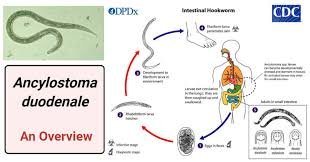What is Ancylostoma Duodenale?
Ancylostoma Duodenale is the scientific name for the Old Worm Hookworm. It gets its name from the fact that it is found almost only in old world countries ( in Africa, Asia, and Europe). The hookworm is one of the two species of hookworms that use humans as their hosts. The other species is Necator Americanus. Ancylostoma Duodenale gets nutrients from the blood of the host. That means it is officially categorized as a parasite.
The Life Cycle of the Species
Ancylostoma Duodenale has three different stages in its life cycle: Eggs, Larvae, and Adults. Eggs of hookworms need warm and moist conditions to survive. Although if it is too wet, they will die. Eggs will hatch, and the larva hookworms will emerge. Crawling into position (normally on a moist blade of grass), the larvae will wait until a host comes along. Hookworm larvae are especially adapted to enter the human body through pores. They can enter through any pore in the body, but they most commonly enter through the feet. When a person steps on a hookworm larva, the act of entering the body irritates the skin. The skin becomes itchy and irritated for a little bit. This can be called a “ground itch.”
Larva
Once in the circulatory system, the larva will make their way to the throat and lungs. They will then be coughed up by the unsuspecting human and swallowed into the digestive tract. Once in the digestive system, they carefully make their way to the lower intestines. This is where they get the second part of their name, Duodenale which means lower intestines. This will be their home for the rest of their life.
Adults, and When the Problem Begins
Once embedded, the hookworm becomes an adult. Now both eggs and larvae are not able to be seen by the naked eye, but adults are able to be seen, although they are so small that most people will never be able to spot one. They just look like very small wriggling maggots. Hookworms are equipped with an extremely sharp mouth which they use to cut into the intestinal wall, gorging themselves on the host's blood, they gain enough energy to begin reproducing.
Reproducing
Ancylostoma Duodenale is incapable of asexual reproduction. So if you only get one hookworm inside of you, it will eventually die and the problem will not escalate further. The problem comes when you get multiple. They reproduce at a very fast rate, pumping out eggs. These eggs exit in the hosts' feces. Then the cycle continues.
Symptoms
Depending on the size of infection, the symptoms can vary, but the most common symptoms are anemia, pica, a bloated stomach, wide eyes, a shuffling stance, and depending on the time someone got the infection, deformed limbs. The hookworms can deprive the body of a lot of blood which can be disastrous for most organs. When young children get large hookworm infections, they can grow up to be a lot smaller and not developing to full maturity.
Prevention
Hookworm cases can increase with a lack of proper sanitation. When a latrine is not properly taken care of it can easily become a health hazard. If there is no safe place to defecate, people resort to the woods. When their feces contain eggs, hookworm infections can easily spread. Thankfully, hookworm infections are easy to treat. A dosage of Thymol (depending on the size of the infection multiple dosages may be needed) which comes from ferns, can easily get rid of the parasites. Thymol is easy to get and cheap. Hookworm infections are now very rare in 1st and 2nd world countries.
Why Does this Matter?
The truth is, it doesn’t really matter. I can almost guarantee that nobody who reads this will ever get infected with hookworms. Sometimes learning about new things is intriguing. I know not everyone enjoys parasites (I’m squeamish at the sight of blood, I get you), but learning something new for the sake of the collection of knowledge is a worthwhile plight.

